| March | April | May | June |
| July | August | September | October |
| November |
Tuesday, 23 November 2010

It's still November and not yet Spring but the snowdrops are in bloom. Galanthus 'Potter's Prelude'
displays its lovely flowers, petals as full and sweetly cupped as a Victorian cream tea spoon.

Sunday, 31 October 2010
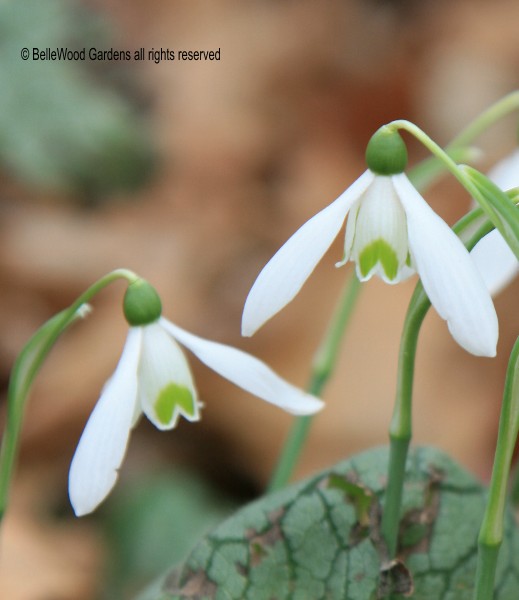
The first of my autumn blooming snowdrops. Divided last Spring as their leaves matured
and now again in bloom in startling topsy turvy, Spring in autumn display.
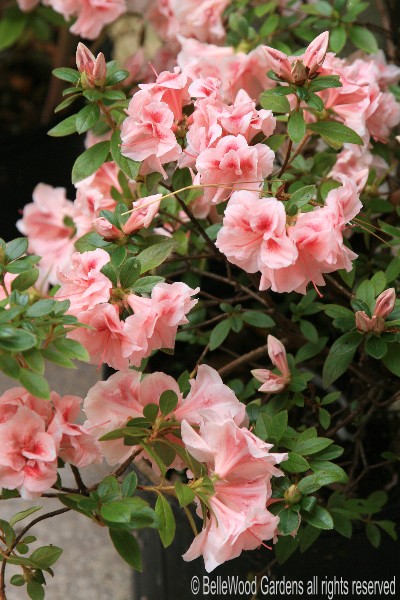
Continuing the down the rabbit hole of just what season are we in?, Encore Azalea Autumn Belle™
happily continues flowering in autumn. The Encore series of remontant azaleas include some that are
indeed winter hardy. I'm not certain if this includes Autumn Belle™ but prefer to keep it under cover in
my attached, unheated garage where they are also protected from hungry deer foraging for a snack.
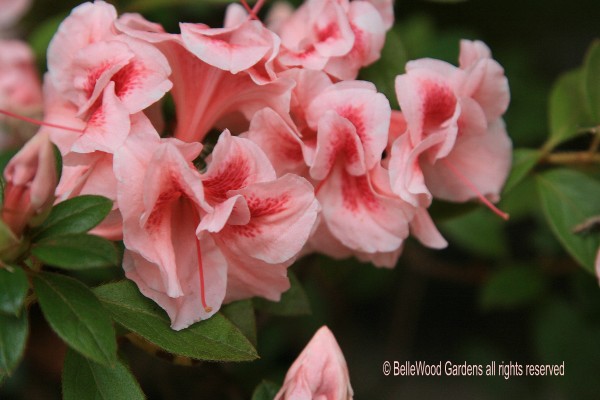
Thursday, 23 September 2010

I am especially fond of colchicum. Their sudden appearance at summer's end add a fresh look to
the garden. Deer resistant, and good cut flowers too. This patch of Colchicum autumnale 'Alboplenum'
has multiplied nicely in my garden. I shared a few with Chanticleer this autumn. Always a good thing.
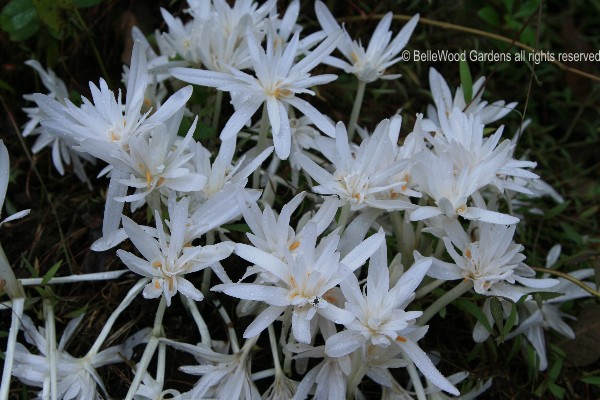
Thursday, 9 September 2010

Call them what you will - oxblood lily, schoolhouse lily, Rhodophiala bifida
is another of the autumn flowering bulbs very dear to me. They thrive in
Giddings, Texas gardens but here in New Jersey they only survive in
my greenhouse. A deep pot, so the bulbs can burrow downward. Dry
all summer long. An dowsing of water in September and up they spring.
Easy, rewarding, remarkable, with dainty yet sturdy vivid red flowers.
Saturday, 14 August 2010

Monday, 2 August 2010

See Ipomoea 'Grandpa Otts' as it twines its way up a dead weeping fig tree,
the first thing I see out the Palladian windows as I come downstairs each morning.

Saturday, 10 July 2010

Agapanthus 'Peter Pan' is modest in size, soft sky blue in color and so very easy
to grow. Keep cool in winter when it needs water only occasionally. Pot bound
seems to suit it just fine. Water regularly once Spring arrives, move outdoors
when mild weather arrives, and it rewards me with a generous display of flowers.

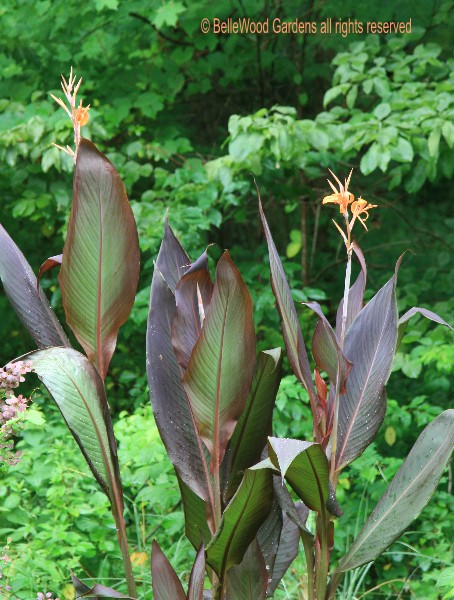
I'm quite fond of cannas, especially as foliage plants. This bronze beauty
is Canna 'Intrigue'. Happy in an outsize pot sited near 'Jack Spratt',
a smaller copper leaved phormium, and Oxalis regnellii 'Triangularis'.
Tuesday, 29 June 2010

Some folks are with one genus of plants or another, be they daffodils or
African violets. I save my enthusiasm for a species or cultivar that speaks
to me. Such as the deep and subtle hue of this Hemerocallis that I used
to think was named 'Heart of Africa'. Finally did a quick web search and
came up empty. Rather, it is simply 'Africa'. Pity. Like my version better.
Sunday, 27 June 2010
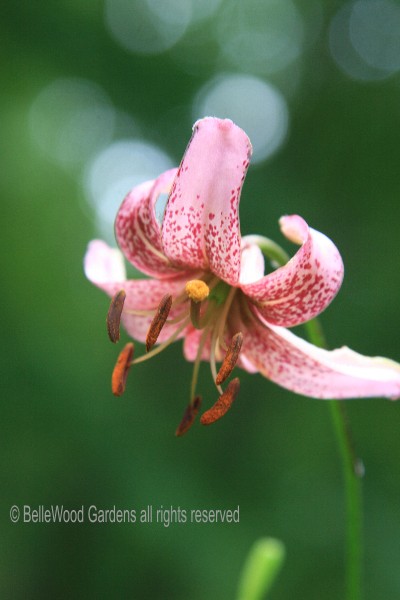
Lilium martagon is tall enough to rise above the weeds
that have taken over at BelleWood Gardens this summer.
But that is what breaking two bones in your ankle will do.
Friday, 25 June 2010
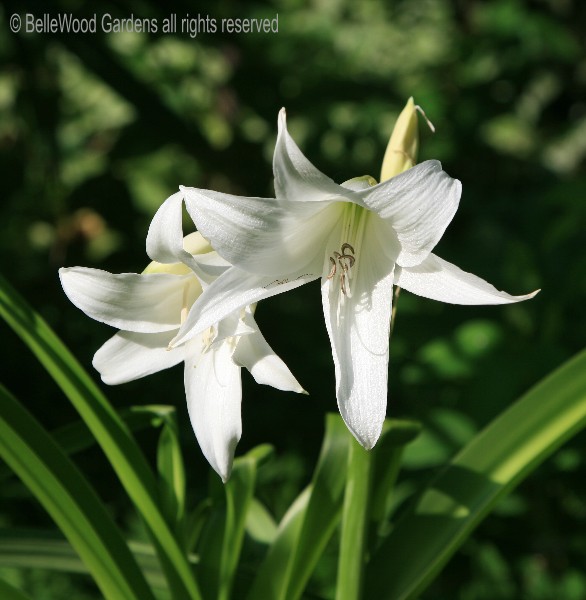
Crinum are sizable bulbs with long necks and sprawling strap-like leaves.
Planted deeply, it is suggested they can survive even here in New Jersey.
Perhaps. Perhaps not. This unnamed version was a gift from a friend, and
is probably Crinum ×powellii 'Album'. Offsets are crowding the already
sizable pot. Perhaps next year I'll try a piece or two in the great outdoors.
Friday, 11 June 2010
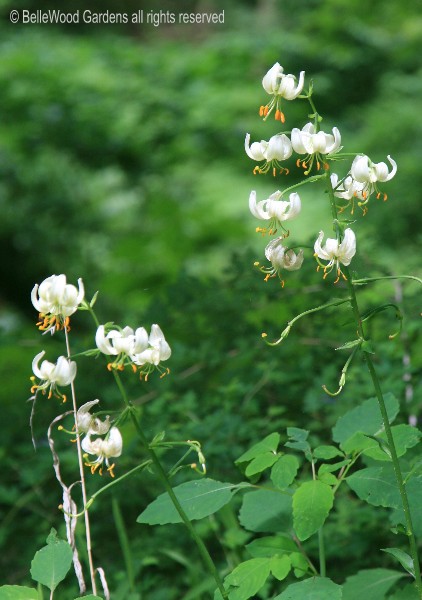
Lilium martagon 'Album' is a wonderful species of lily. Dainty in size,
the strongly reflexed petals have great substance. Goodly numbers appear
on sturdy stems, white flowers accented by golden pollen on the stamens.
Monday, 31 May 2010

Persicaria polymorpha is possibly the only well behaved member of a perniciously invasive clan.
Looking like an outsize astilbe it grows as an enlarging colony, similar to maiden grass, Miscanthus.
Very different from Japanese bamboo, Polygonum cuspidatum, which is an obnoxious, invasive weed.
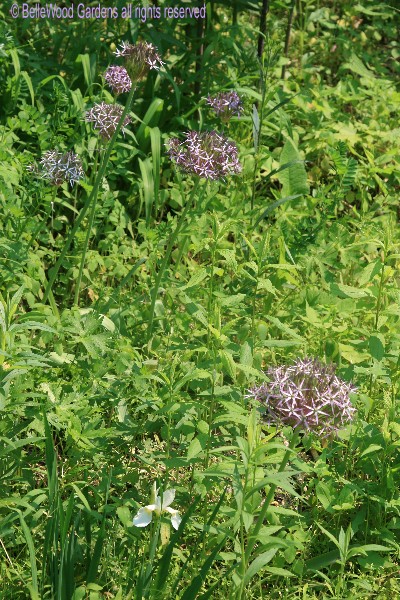
Allium christophii is one of my favorite ornamental onions. Lilac
star-like flowers form an umbel (a flower head with several to many
short flower stalks, equal in length and spreading from a common point
- like a dandelion's seed head.) Equally beautiful when gone to seed.

.

"Perennial" is a relative term applied to herbaceous plants that live more than 2 years. Equally valid
for peonies that thrive for 50 years and a columbine that fades away in 5 years. At least columbines
seed about, forming a repeating colony. This purple and white strain has been reseeding for years.

Handsome magenta splotched purple leaves of Oxalis regnellii atropurpurea make it a suitable partner
for canna with purple leaves. Tolerant of some shade, pair it with caladiums for an attractive combination.

As appealing as a ballerina's ruffled tutu, the palest pink flowers of a double peony in lavish bloom.

A red, red David Austin rose.
Friday, 21 May 2010
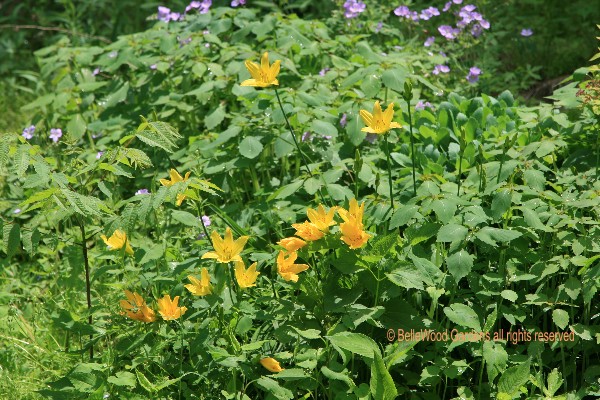
Lemon lily, Hemerocallis lillioasphodelus. is one of the plants that accompanied me to New Jersey
when we moved here 15 years ago. I had found it growing along the road near an abandoned house
in an overgrowth of poison ivy. Worth the itch to collect some, as this early blooming, deliciously
fragrant, pale yellow day lily is difficult to find at nurseries, which prefer to sell cultivars, new ones.
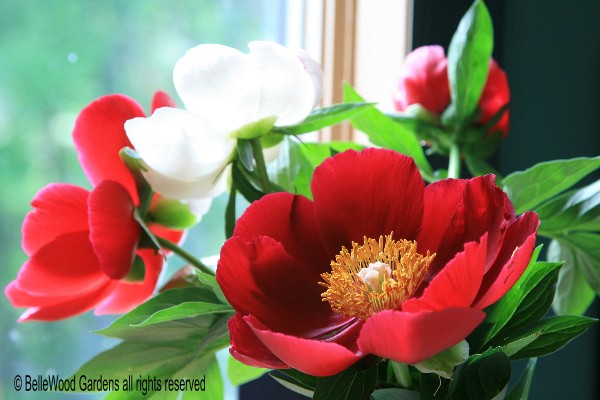
When Joan and Pat came to visit, bringing sustenence in the form of lasagna, a salad, and blueberry crisp
I gave them an assignment. Sent them out to the garden with a vase and a pair of scissors, and requested
that they pick some peonies for me to enjoy while still housebound by my broken ankle. Dear ladies that
they are they came back with some buds showing great color that have now opened up magnificently.
All I need to do is turn my gaze away from the computer screen to this vase of 'Illini Warrior' & appreciate
both my friends and the garden that is flowering without me. I'll be out there before the summer is over . . . . .
Thursday, 8 April 2010
Daffodils are in bloom here at BelleWood Gardens

Here's one of my favorites, the (usually) May flowering Narcissus poeticus. Its common name
is Pheasant Eye, perhaps for the short ruffled little fringe of a cup edged with red that contrasts
so strongly against the crystalline white petals. Legend names it as the flower into which Narcissus
was transformed, and also as the flower Persephone was gathering when captured by Hades and
taken down into the Underworld. As explanation of why we have winter it may be less than valid.
However I'm happy to welcome these fragrant flowers as a signal of Spring's return, year after year.


Other daffodils also welcome Spring, such as charming little 'Dove Wings' which opens with a yellow cup
that fades to soft, old ivory white as it matures. The swept back petals hark to its cyclamineus ancestry.

'Ice Follies' is arguably one of the most popular daffodil cultivars. This relatively modern cultivar was
introduced in 1953. It is classified as Division II or large cup daffodil. Again, the cup opens yellow
and then fades to ivory white. It performs reliably in the landscape, is suitable both for forcing and as
a cut flower, no wonder it has found a home in so many gardens, including here at BelleWood Gardens.

Bulbs are about the earliest and best of flowering plants to announce
winter's waning days. By early April they're on a roll with diverse kinds
in bloom - like the little Guinea hen flower, leper's lily, snake's head lily,
Fritillaria meleagris, whose chequered bells are overlook by deer
and happily thrives in damp, slightly shady places, even reseeding a bit.

A native bulb that's happy here is the dainty squirrel corn,
so named for the plump yellow scales that form the bulb.
Less well known than its Dutchman's breeches relative,
Dicentra canadensis is also charming in the spring woodland.

As is the dogtooth violet, aka adder's tongue, trout lily, or fawn lily.
Once settled in place and able to dwell deep and bulk up the little bulb
shaped like a dog's canine tooth, Erythronium americanum will grow
a pair of leaves and a single flower more like a miniature lily than a violet.
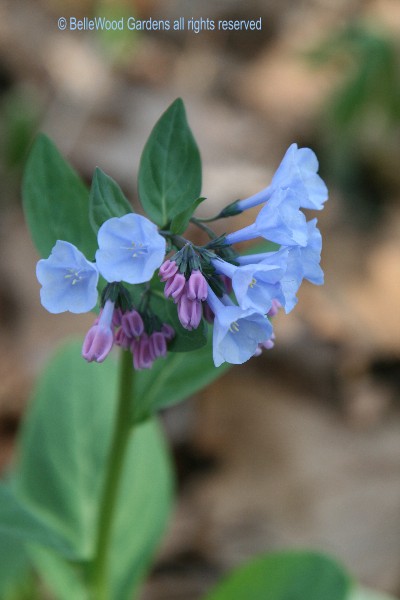
Virginia bluebells, Mertensia virginica, thrive in rich damp soil
along tree-shaded river bottoms. Mine multiply generously and there
are a few individuals whose pink buds rather than opening into blue
flowers remain pink - apparently two clones of slightly different hues.

Daffodils and Guinea hen flower, squirrel corn, dogtooth violet, and
Virginia bluebells are ephemerals. They appear, flower, then fade away
until next year. Trillium grandiflorum also blooms in spring but even
after the flowers fade its leaves remain throughout the growing season.

A number of our native plants - including trillium - have "cousins" from abroad, especially China
and Japan. While we have just two or three species of Arisaema ( this depends on if the taxonomist
you're using is a splitter or a lumper) there are many more abroad. Take this barely open ET-like charmer,
Arisaema thunbergii variety urashima with long whiplike extension on its spadix. Agreed, seriously cute?

Last month, in A Visit to Buck Garden I took serious aim at lesser celandine, Ranunculus ficaria, as
a thuggish plant of high order, one that spread far and wide and is difficult to eradicate. You could be
pardoned for wondering why I would then deliberately plant some in my garden. Because this exquisite
double form and a couple of other cultivars are much, much better behaved and increase only slowly.
Sunday, 21 March 2010

There was so much snow in end-of-winter storms that Dave had trouble
finding somewhere to pile it all up the last couple of times he plowed
our driveway, making a mound 7 feet high & 8 feet thick. The result?
Even with yesterday & today's unusual 20 degrees warmer than normal
temperatures - absurd 70° Fahrenheit, in March - look what's still here.

Then there was the flood of March 13 - 15, with 5 or so inches of rain. The drainage creek
got rearranged. Just look at how the water scoured the channel and shifted things about.

Water did some channeling on the landscape also. See the exposed Corydalis solida bulbs.
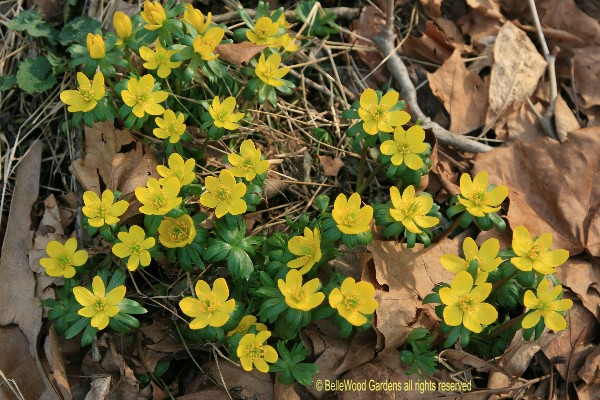
Most of the garden areas are fine. Bulbs are bursting into bloom: colonies of winter aconite, Eranthis hiemalis

and spring snowflake, Leucojum vernum, happily multiplying in a damp area above the drainage creek.
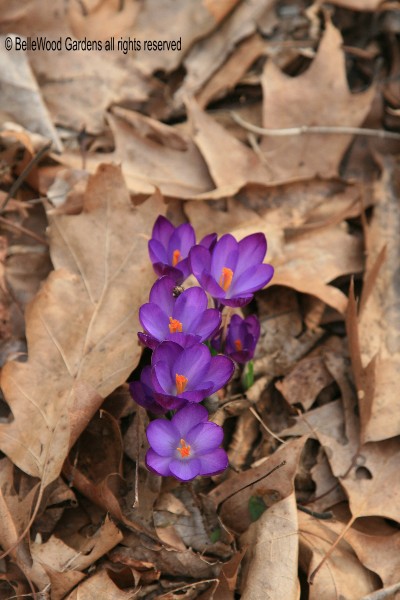
Deep purple flowers of the little woodland crocus, Crocus tommasinianus 'Whitwell Purple'

and green-tipped flowers of Galanthus nivalis 'Viridiapicis'

while Cyclamen coum's intense fuchsia flowers glow against the fallen leaves.

In a sunnier site at the toe of the slope behind the house Bulbocodium vernum makes its appearance.
Its bulbs resemble those of colchicum, just smaller in size. Their family is Colchicaceae and recently
I read that taxonomists have changed its name so now I must remember to call it Colchicum vernum.
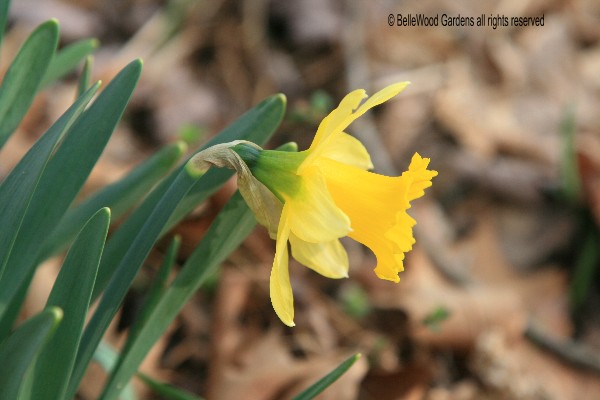
Daffodils will always be named daffodil, and it would be a brave soul who altered Narcissus.

Hellebores in the Early Purple Group are among the first to flower. And
while they thrive they do not seem to seed about. I must dig and divide
in order to multiply. A balancing act - of course I want more but
hesitate to disturb the plants that are so happily growing.

Lenten rose, Helleborus× orientalis, does well in BelleWood Gardens woods.

As does Christmas rose, Helleborus niger. I wait until
self-sown seedlings get a couple of years growth, then
shift them about, here and there and elsewhere in the garden.

Sometimes there's a correspondence between Latin and common names
as with lungwort and Pulmonaria. Supposedly the spotted leaves resemble
diseased lungs. And by the Doctrine of Signatures that meant the plant was a cure.

Not dandelion, but coltsfoot, Tussilago farfara, and like dandelion a non-native that immigrated
from abroad. In this case, from Europe, western and northern Asia, and North Africa.
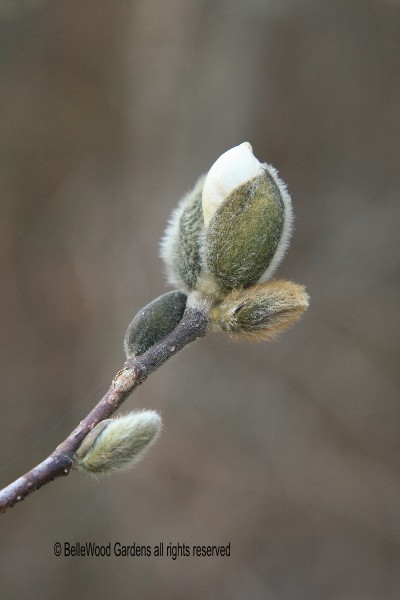
The furry buds of star magnolia, Magnolia stellata, are beginning to open.
Tuesday, 16 March 2010

First of the spring snowflake, Leucojum vernum, have come into bloom.

Galanthus woronowii with grass-green leaves is in flower on Midway Path.

And the ethereal white flowers of Eranthis pinnatifida make their welcome appearance.
Wednesday, 10 March 2010

Pussy willows have shed their stiff bud cases and reveal
expanding velvety gray catkins. As yet, no pollen for early bees.

Winter is, at last, melting away in a patchwork of old snow and sodden leaves.

And where snow goes, snowdrops emerge.

A charming cultivar with petals as sweetly rounded as cream tea spoons.
Note to self - as flowers fade be sure to divide this congested clump.

Winter aconite, Eranthis hiemalis, scatters sunshine with its golden flowers. Once happily established
it seeds about with ample enthusiasm. Belonging to Friday, Ranunculaceae plant & tubers are pest resistant.
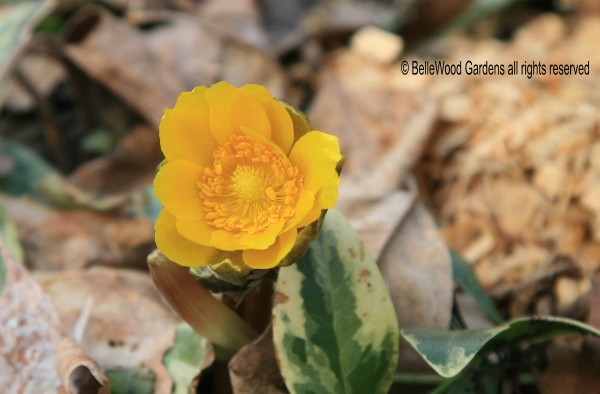
Another member of Family Ranunculaceae, Adonis amurensis is one of the earliest perennials to bloom.
Call it ephemeral or fugacious. Like the earliest bulbs, it will quickly vanish for the rest of the year.

Another early perennial, Helleborus foetidus presents its apple green flower buds, not yet expanded into bloom.